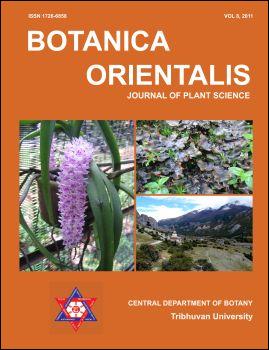Bioactivity and biochemical analysis of water hyacinth (Eichhornia crassipes)
DOI:
https://doi.org/10.3126/botor.v8i0.5556Keywords:
biological screening, extracts, phytochemical assay, zone of inhibitionAbstract
Water hyacinth (Eichhornia crassipes) is an invasive aquatic weed causing serious threats to water ecosystems throughout the world. Recently, considerable attention has been given at harvesting the plant for practical uses. An experiment on the bioactivity of water hyacinth was conducted using the soxhlet extraction (hot method) and cold percolation method in chloroform and ethanol in order to evaluate the antimicrobial properties of the plant. Plant samples were also analyzed for the presence of major pharmacologically active compounds. The antimicrobial assay was performed using well diffusion method against nine different clinical bacterial strains and six phytopathogenic fungal strains. The chloroform hot extract showed activity against 22.22% (Zone of Inhibition, ZOI < 13mm) bacteria and 66.66% (ZOI < 12mm) fungi; while the cold extract showed activity against 50% (ZOI < 13mm) fungi, but no activity against bacteria. Similarly, the ethanol hot extract showed activity against 77.77% (ZOI < 19mm) bacteria and 66.66% (ZOI < 20mm) fungi, while the cold extract showed activity against 77.77% (ZOI < 10mm) bacteria and 50% (ZOI < 14mm) fungi. The ethanolic hot and cold extract proved to be far better than the chloroform fraction showing more antibacterial activity, while they share the same value and possess same effectiveness against the different fungi. Chemical analysis indicated that the major components in these extracts were saponins, polyoses, alkaloid salts, and reducing compounds. The present study showed that the devastating aquatic weed, with strong antimicrobial potentials and presence of biologically active phytochemicals, may be useful for developing alternative compounds to treat infectious diseases caused by bacterial and fungal pathogens.
doi: http://dx.doi.org/10.3126/botor.v8i0.5556
Botanica Orientalis – Journal of Plant Science (2011) 8: 33-39




